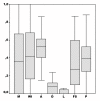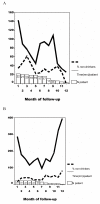Clinical management methods for out-patients with alcohol dependence
- PMID: 16722570
- PMCID: PMC1436000
- DOI: 10.1186/1747-597X-1-5
Clinical management methods for out-patients with alcohol dependence
Abstract
Background: In France outpatient centres for the care of alcoholics are healthcare establishments providing medical, psychological and social support. Although they meet the practical needs of these patients, their degree of use in each of these domains and the respective mobilisation of different skills by the care team are not well understood. Our aim was therefore to determine in detail the management involved as a function of the severity of alcohol dependence. For this purpose, all the procedures involved were compiled in a thesaurus describing its type (psychological, medical, social, reception), its scheduled or unscheduled nature, its method (face-to-face, telephone, letter) and its duration. The severity of dependence was evaluated using the Addiction Severity Index (ASI).
Results: 45 patients were included and followed-up during 291 +/- 114 days. The mean initial ASI scores (+/- SD) were: medical (M) = 0.39 +/- 0.3, working-income (ER) = 0.5 +/- 0.3, alcohol (A) = 0.51 +/- 0.2, illicit drugs (D) = 0.07 +/- 0.08, legal (L) = 0.06 +/- 0.13, familial and social environment (FS) = 0.34 +/- 0.26, psychological (P) = 0.39 +/- 0.22. The total number of procedures was 1341 (29.8 per patient) corresponding to 754.4 hours (16.7 per patient). The intensity of management peaked during the first month of treatment, and then declined rapidly; the maximum incidence of abstinence was observed during the 3rd month of management. Interviews with patients, group therapy and staff meetings represented 68.7%, 9.9% and 13.9% of all procedures, respectively. In patients with severe dependence, as compared to moderate, management was twice as intense in the psychological and social domains, but not in the medical domain. The ASI questionnaire was completed a second time by 24 patients, after an average of 3.2 months. The improvement was significant in the M, A, D and P domains only.
Conclusion: This study provided an overview of the methods employed in managing a sample of patients consulting an alcoholism centre in line with standards for medical, psychological and social establishments. The predominance of the social and psychological domains over the medical domain was clearly established. Relapses were common after the third month of treatment, but a remobilisation of teams made it possible to contain them. These results provide a framework for discussions on the organisation of healthcare systems and highly suggest that staff need to maintain a constant level of care throughout the treatment process.
Figures




Similar articles
-
The effectiveness of telephone-based continuing care for alcohol and cocaine dependence: 24-month outcomes.Arch Gen Psychiatry. 2005 Feb;62(2):199-207. doi: 10.1001/archpsyc.62.2.199. Arch Gen Psychiatry. 2005. PMID: 15699297 Clinical Trial.
-
Impact of practitioner's training in the management of alcohol dependence: a quasi-experimental 18-month follow-up study.Subst Abuse Treat Prev Policy. 2006 Jul 14;1:18. doi: 10.1186/1747-597X-1-18. Subst Abuse Treat Prev Policy. 2006. PMID: 16842620 Free PMC article.
-
Randomised controlled trial of non-directive counselling, cognitive-behaviour therapy and usual general practitioner care in the management of depression as well as mixed anxiety and depression in primary care.Health Technol Assess. 2000;4(19):1-83. Health Technol Assess. 2000. PMID: 11086269 Clinical Trial.
-
[Interest of a new instrument to assess cognition in schizophrenia: The Brief Assessment of Cognition in Schizophrenia (BACS)].Encephale. 2008 Dec;34(6):557-62. doi: 10.1016/j.encep.2007.12.005. Epub 2008 Jul 9. Encephale. 2008. PMID: 19081451 French.
-
[Prospective study of favorable factors in follow-up of drug addicted patients--apropos of 257 patients of the Cassini Center in Paris].Encephale. 2000 Nov-Dec;26(6):11-20. Encephale. 2000. PMID: 11217533 French.
Cited by
-
Psychosocial findings in alcohol-dependent patients before and after three months of total alcohol abstinence.Front Psychiatry. 2010 Jul 6;1:17. doi: 10.3389/fpsyt.2010.00017. eCollection 2010. Front Psychiatry. 2010. PMID: 21423428 Free PMC article.
References
-
- Official Journal of the French Republic, 29 December 1998, decree n°98-1229
-
- McLellan AT, Luborsky L, Woody GE, O'Brien CP. An improved diagnostic evaluation instrument for substance abuse patients, the Addiction Severity Index. Journal of Nervous and Mental Disease. 1980;168:26–33. - PubMed
-
- Crouzet C, Maggia B, Nalpas B, Latorre B, Daures JP, Balmes JL. Les travailleurs sociaux: des observateurs privilégiés de l'alcoolisme. Alcoologie et Addictologie. 2001;23:507–11.
-
- Heide M. But they are capable of change... Fifteen year experience in sociotherapeutic work with chronic alcohol-dependent women and men. Alcologia. 1995;7:141–7.
Publication types
MeSH terms
LinkOut - more resources
Full Text Sources
Medical

